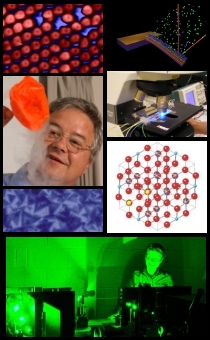Condensed Matter Experiment
Overview
We study hard materials (for magnetic, optical, photonics, and sensor applications) as well as soft matter (to better understand ordering and dynamics of biological and colloidal systems).
Our interests span bulk materials, thin films and multilayers, and surfaces and interfaces. Techniques used span Brillouin, Raman and femtosecond laser spectroscopy, ultrasonic spectroscopy, wideline and pulse-field gradient nuclear magnetic resonance (NMR) spectroscopy and imaging, and scanning probe and laser-scanning confocal microscopies, in addition to electrodeposition, magnetometry, as well as several other materials characterization techniques available on campus.

Research Groups
- G. T. Andrews
Photonic materials analysis and characterization via laser spectroscopy (Brillouin, Raman, photoluminescence); Fabrication of porous semiconductor films and multilayers; Porous silicon; Carbon nanotube arrays. - L. Y. Beaulieu
Laboratory of Materials Science and Scanning Probe Microscopy: Pushing the limits of molecular recognition with cantilever-based sensors. - V. Booth
Biophysics: protein NMR, molecular dynamics simulation, membrane-bound protein structure-activity relationships. - Q. Chen
Photonic materials, devices and applications, especially at ultrafast time scale and nanometer scale. - M. J. Clouter
Brillouin, Raman, Wide Bandgap Semiconductors, Porous SiC, Surface Acoustic Waves, Ferroelectrics, Ferroelastics. - M. R. Morrow
Wideline deuterium NMR studies of phospholipid bilayers and model biological membranes: membrane order and dynamics at hydrostatic pressures up to 270 MPa; protein-lipid interactions in pulmonary surfactant material models; orientation and dynamics of transmembrane polypeptides. - K. M. Poduska
Materials Physics: Tuning the magnetic, optical and mechanical performance of substrate-supported metal oxide materials. Electrodeposition, scanning probe microscopy in fluid, X-ray diffraction, magnetometry, optical spectroscopy (UV-Vis, Raman). - G. Quirion
Ultrasound measurements of phase transitions in low-dimensional systems. - A. Yethiraj
Structure and kinetics of self-assembly in soft matter, colloids,self-assembled nanostructures, surfactant mesophases. Primary techniques used: fluorescence laser-scanning confocal microscopy and pulsed-gradient NMR spectroscopy and imaging.